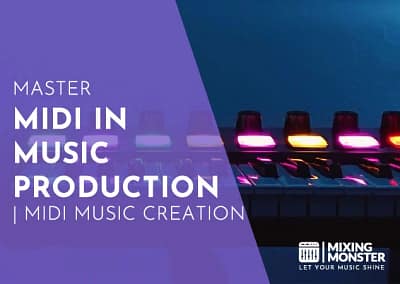Home > Blog > Studio Gear > Recording Gear
Disclosure: Some of the links below are affiliate links, meaning that at no additional cost to you, we will receive a commission if you click through and make a purchase. Read our full affiliate disclosure here.
Whether podcasting, streaming, or laying down tracks in the studio, the quest for that perfect, clean sound is paramount. We recently got our hands on the Shure SM7B, and let’s say it’s a game-changer regarding vocal microphones.
The Shure SM7B is a dynamic microphone renowned for its exceptional audio performance in professional settings. It features a comprehensive frequency response well-suited for capturing both instrumental and vocal sounds with high fidelity.
The microphone’s design includes:
- A robust build quality.
- Internal shock-mounting to reduce handling noise.
- A built-in pop filter to mitigate plosive sounds.
Additionally, the SM7B is equipped with advanced electromagnetic shielding, which minimizes the impact of environmental electronic interference on audio quality.
As we delve deeper into our Shure SM7B review, it’s necessary to notice its omnipresence in top broadcasting and streaming studios. It’s not just about the specs – this microphone brings proven reliability, exceptional audio quality, and ease of use. We’re diving into how it stands up to real-world applications and why it may be the professional-grade microphone you’ve been looking for.
KEY TAKEAWAYS:
- Having tested the SM7B, we understand its high ratings and widespread appeal.
- Only some microphones can deliver such consistently precise and natural audio.
- Are you interested in raising the bar for your vocal recordings?
Click here to purchase the Shure SM7B and capture sound with unprecedented clarity!
Table Of Contents
1. Shure SM7B Review – Microphone Overview
2. Studio Versatility Of The Shure SM7B
3. Podcasting And Broadcasting With The Shure SM7B
4. Professional Live Streaming With The Shure SM7B
5. Advanced Electromagnetic Shielding Of The Shure SM7B
6. The Shure SM7B: Built For Close-Miking And ASMR
7. Pros And Cons Of The Shure SM7B
8. Customer Reviews Of The Shure SM7B
9. The Shure SM7B Dynamic Microphone: A Class Of Its Own
10. FAQ
1. Shure SM7B Review - Microphone Overview
From the moment we unpacked the Shure SM7B, its robust construction and charcoal gray finish conveyed a professional quality. The microphone is a staple in both music and broadcast industries, and after testing it in various settings, we understand why it’s so revered. Its wide-range frequency response provides clear and natural audio reproduction, whether you’re recording vocals in a studio or speaking on a podcast.
The SM7B’s advanced electromagnetic shielding is a standout feature, efficiently countering the hum from electronic devices, which was particularly noticeable in our setup with multiple monitors. Including a standard windscreen and an A7WS windscreen for close-talk applications reflects the microphone’s versatility.
While the sound clarity and noise rejection are impeccable, potential users should know that this mic may require a potent preamp or audio interface to achieve the best results. It may only suit some, especially those on a budget or with simpler recording setups.
We’ve boiled down the primary features into a table for clarity:
| Features | Description |
|---|---|
| Versatility | Ideal for studio recording, podcasting, streaming. |
| Flat Frequency Response | Ensures clean, natural sound for music and speech. |
| Pop Filter and Shock Mount | Eliminates mechanical noise and breathiness. |
| Cardioid Pickup Pattern | Rejects off-axis sounds for focused recordings. |
| Electromagnetic Shielding | Minimizes interference from other devices. |
| Professional XLR Connection | Allows nuanced sound control. |
| Included Windscreens | A7WS for close applications, standard windscreen. |
| Rugged Construction | Durable with an improved mounting system. |
Through our usage, the SM7B has shown itself to be a reliable and high-quality choice for audio-severe professionals. However, for those new to audio production, there might be a learning curve to get the most out of this dynamic microphone. Its performance is outstanding, but its full potential is only realized with proper additional equipment and setup.
2. Studio Versatility Of The Shure SM7B
When recording in the studio, we look for gear that offers quality and flexibility. The SM7B consistently impresses with its ability to produce clear and natural audio for various applications. The comprehensive frequency response ensures that the sound is faithfully captured without unwanted coloration, whether we track vocals or close-miking instruments.
Despite its robust construction, fine details, like the effective pop filter and the air suspension shock isolation, enhance the recording experience by minimizing mechanical noise and breathiness. This is crucial for us to deliver professional-grade recordings devoid of distracting sounds.
One downside, we’ve observed, is that this mic requires a substantial amount of gain to reach its full potential, which might necessitate an additional preamp. However, when set up correctly, the SM7B‘s performance is consistently reliable, whether for podcasts, streaming, or music production.
It’s clear why this microphone is a staple in studios worldwide; its audio isolation and clean sound reproduction are hard to beat, even though it might be a heavier investment for some.
3. Podcasting And Broadcasting With The Shure SM7B
We can attest to its standout performance by using the SM7B firsthand in various podcasting scenarios. Broadcasters and podcasters often seek a mic that can deliver precise, natural speech reproduction, and this mic fits the bill.
Its air suspension shock isolation and pop filter are essential features, efficiently eliminating unwanted noise and breathiness from audio. This results in recordings that let through the intended words while leaving out any intrusive sounds.
The cardioid pattern of the SM7B is beneficial for podcasting since it focuses on capturing the sound source while rejecting off-axis noise. This directional approach allows us to speak comfortably without worrying about picking up unnecessary ambient sounds. Its XLR connection is also a significant advantage, giving us finer audio control when paired with a decent audio interface.
However, it’s essential to acknowledge that the SM7B may only be optimal for some. It requires significant gain, and the output might be higher than expected with a proper preamp. Additionally, its hefty build and need for a stable mounting system might only suit some studio setups.
Our experience suggests that the SM7B shines when recording voice-driven content where clarity and warmth are paramount. Yet, it’s wise to consider your studio environment and equipment before deciding if this famed microphone will be the right choice for your broadcasting or podcasting needs.
4. Professional Live Streaming With The Shure SM7B
When you’re live streaming, audio quality can be the make-or-break factor in audience engagement. Our experience with the SM7B clarifies why it’s a top choice for professionals. The microphone captures voice with exceptional clarity, lending a polished sound to live streams for gaming, podcasting, or music performances.
The built-in pop filter and shock isolation reduce unwanted noise, ensuring our words are what the audience hears, not the computer’s background hum or the desk’s accidental bump. The cardioid pattern is a standout feature that focuses on our voices and minimizes off-axis sounds, which is great when we can’t control the environment around us.
However, not all setups might be equipped to handle it without a separate preamp—something to consider before integrating the SM7B into your streaming setup. And while the microphone is robust and the audio quality is stellar, the heft might require a sturdy boom arm for proper placement.

5. Advanced Electromagnetic Shielding Of The Shure SM7B
In our experience with the SM7B, one standout feature is its ability to resist electromagnetic interference. The mic is designed to be practically impervious to the hums and buzzes that can plague recordings, especially in environments with a lot of electronic equipment.
When working near computer monitors or under strong neon lights, the shielding ensures a clean audio signal, which is vital for music and voice work. We’ve noticed the difference it makes, especially when using the microphone in a home studio surrounded by various electronic devices. It does keep that unwanted electrical noise at bay.
The SM7B is robust in construction, and this attribute extends to its electromagnetic defense. The result? A distinct clarity in the sound is captured. It’s particularly beneficial for streamers and podcasters, who might not have the most controlled environments but still require professional-quality audio free from interference.
6. The Shure SM7B: Built For Close-Miking And ASMR
When capturing the subtle nuances of voice work or the delicate sounds of ASMR, a microphone’s ability to handle close-miking is crucial. We’ve found that the SM7B excels in this realm.
Its included A7WS windscreen is tailor-made for close-talk applications, meaning those hushed tones and quiet details come through with clarity.
Working in environments filled with electronic devices could pose a challenge, but the SM7B’s advanced electromagnetic shielding ensures a clean signal free from that annoying hum. The sound quality is unmistakably warm and smooth—a dream for ASMR artists and vocalists alike.
However, we also recognize and mentioned before that for the best results, you’ll need a decent preamp with enough gain; otherwise, the microphone’s output can be pretty quiet. This combination of professional-level performance and requiring a bit of extra gear makes the SM7B a double-edged sword.
Still, in our experience, the robust build and quality sound capture are worth the investment, especially for those serious about their audio.
7. Pros And Cons Of The Shure SM7B
Pros Of The Shure SM7B
Our time with the SM7B has shown it to be a versatile and reliable choice for many audio tasks. Its clean and natural sound reproduction is prized, making it a go-to for vocal recordings in a studio setting.
Podcasters and streamers will appreciate that mechanical noise and breathiness are significantly reduced, thanks to its air suspension shock isolation and pop filter. Live streaming content benefits from the mic’s ability to capture speech and music authentically.
Another major plus is the professional XLR connection, which provides more control over sound quality when paired with an appropriate audio interface. Its cardioid pattern is noteworthy for capturing on-axis audio cleanly while effectively minimizing off-axis noise, a feature performers and broadcasters rely on for clear audio capture.
Furthermore, the electromagnetic shielding is an excellent addition that combats hum from other studio equipment, ensuring a cleaner signal. For those engaged in close-miking instruments or creating immersive ASMR content, the SM7B‘s performance is stellar, delivering warmth and smooth frequency response.
Cons Of The Shure SM7B
Despite its many advantages, the SM7B could be better for some situations. Its need for a substantial gain could necessitate a high-quality preamp, which may be an additional investment for some users. The microphone’s heavier and robust construction could challenge smaller setups or those who frequently adjust their microphone position.
Another consideration is that the SM7B’s detailed sound reproduction can be unforgiving to imperfect room acoustics or less-than-ideal vocal techniques, which means additional time and resources might be required to optimize recording conditions.
Lastly, it’s essential to mention the price point. While it’s a fair value for the professional quality it brings, the investment could be significant for amateurs or those just starting with audio production. The SM7B is an excellent tool, but it’s crucial to understand its traits and requirements to ensure it matches your specific needs.
8. Customer Reviews Of The Shure SM7B
In our pursuit to provide a comprehensive look, we took to the internet to gauge general sentiment about the SM7B. The consensus is overwhelmingly positive. With an average rating of 4.8 out of over 10,000 ratings, it’s clear that this microphone has a strong following.
Many customers highlight the SM7B’s performance and signature sound quality as a notable strength. The microphone’s glossy black appearance also receives compliments, making it visually appealing in any setting. Reviewers shared experiences of significant improvements in their vocal recording quality, which affirms its popularity among professional broadcasters and podcasters.
However, it’s also been mentioned that the SM7B may only suit some. Its nuances and specific needs, like a good preamp, can be a hurdle for those less versed in audio equipment. Some also mentioned the microphone’s weight as being heavier, which is something to consider depending on your studio setup.
Considering all the feedback, the SM7B has become a reliable choice for audio professionals seeking pristine sound quality, albeit with some considerations regarding setup and user compatibility.
9. The Shure SM7B Dynamic Microphone: A Class Of Its Own
The Shure SM7B has become a staple in our recording arsenal for its exceptional sound quality in professional settings. Its smooth frequency response ensures that both vocals and instruments are captured with clarity and a natural tone. Thanks to its excellent shielding, it excels in environments where electromagnetic interference could be an issue.
This mic has seen upgrades over the years, including a more stable bracket design and a versatile array of windscreens for different applications. One moment, it’s helping us achieve broadcast-quality audio in podcasting with its built-in air suspension shock isolation; the next, it’s capturing the subtle nuances of singing performance.
However, it’s important to note that while the SM7B is a powerhouse in sound isolation, its need for a high gain input might require an additional preamp—a consideration worth noting for those eyeing this mic. Its XLR connection also means a proper audio interface is essential. Despite these requirements, the results are worth the setup, offering a professional edge that can elevate any project.

Recap Of The Shure SM7B
- Trusted by vocalists and podcasters alike
- Clean, flat frequency response for natural audio reproduction
- Superior electromagnetic hum rejection for clear sound
- Versatile for both streaming and professional recording
- Cardioid pattern minimizes unwanted sounds
- Durable construction with premium materials
Mixing
Service

Mastering
Service

10. FAQ
1) What type of microphone is the Shure SM7B?
The SM7B is a dynamic microphone designed primarily for vocal use. It shines in recording environments due to its flat, wide-range frequency response, ensuring a transparent and authentic sound reproduction.
2) How does the Shure SM7B compare to the Shure MV7 and SM58 regarding recording quality?
The recording quality of the SM7B is exceptional, offering a studio-quality sound that outperforms the MV7 when it comes to refinement and the ability to capture subtleties. It’s also a step up from the SM58, which is more rugged and designed for live performances, while the SM7B is tuned for detailed studio work and richer vocal reproduction.
3) Can the Shure SM7B be connected via USB?
No, the SM7B utilizes an XLR connection and requires an audio interface or a mixer. For USB functionality, a separate XLR-to-USB signal converter would be necessary.
4) Is the Shure SM7B suitable for professional vocal recording?
Absolutely. The SM7B is a professional standard in the industry, trusted for precisely capturing vocals. It’s widely used in radio, podcasting, and music production for its reliability and high-quality sound.
5) Does the Shure SM7B require a preamp or additional equipment to perform optimally?
The SM7B benefits from a good quality preamp with enough gain, preferably 60dB or more, to maximize the microphone’s dynamic range. Some may also use an external processor or audio interface to refine the sound further.
6) How does the price of the Shure SM7B reflect its performance and features compared to other microphones in the market?
The SM7B is priced higher than entry-level microphones, but its cost indicates its professional-grade quality. Compared to its peers, the SM7B offers robust construction, excellent sound isolation, and the iconic Shure audio clarity, making it a long-term investment for serious audio professionals. The price-to-performance ratio aligns well with the expectations for a microphone of this caliber.
Next Steps


You Might Also Be Interested In

45+ Best Practices For A Perfect Home Studio Setup In 2024

Music Production Guide 2024 | Full Instructions For Beginners

How To Mix Music In 2024 | An Easy Guide For Beginners

How To Master Music In 2024 | Mastering Guide For Beginners

How To Record Music In 2024 | A Practical Beginner’s Guide

How To Edit Audio In 2024 | Essential Guide For Beginners

Best Studio Gear 2024 | Top Equipment For Every Budget

#1 Best Mixing Service 2024 Online | Studio Mixing Monster

#1 Best Mastering Service 2024 Online | Studio Mixing Monster






















